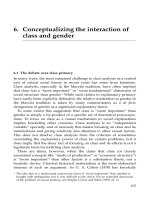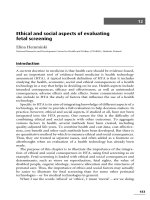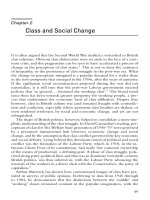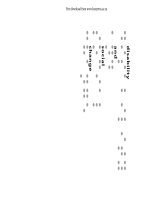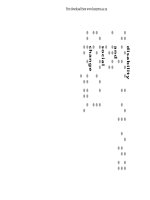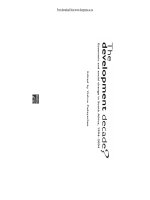Class and Social Change
Bạn đang xem bản rút gọn của tài liệu. Xem và tải ngay bản đầy đủ của tài liệu tại đây (168.68 KB, 34 trang )
Chapter 2
Class and Social Change
It is often argued that the Second World War marked a watershed in British
class relations. Obvious class distinctions were set aside in the face of a com-
mon crisis, and this pragmatism can be seen to have accelerated a process of
change in the perception of class status.
1
This is not to deny the existence
of inequality, or the persistence of class struggle in the post-war era. What
the change in perception instigated is a popular demand for a wider share
in the new prosperity that emerged in the 1950s, after the years of austerity.
If the egalitarian social reconstruction proposed during the war did not
materialize, it is still true that the post-war Labour government enacted
policies that ‘in general ...favoured the working class’.
2
The broad trend
since then has been towards greater prosperity for working people, a pro-
cess that undermines the economic basis of class affiliation. Despite this,
however, class in British culture was (and remains) fraught with contradic-
tion and confusion, especially where persistent class loyalties are shaken, or
even rendered irrelevant, by social and economic change, and yet are not
relinquished.
The shape of British politics, however, helped to consolidate a more sim-
plistic understanding of the class struggle. In David Cannadine’s reading, per-
ceptions of class for ‘the Welfare State generation of 1945–79’ were governed
by a presumed instrumental link between economic change and social
change, and by the assumption that class conflict governed the key economic
and social debates. Lying behind this dominant mood of political and social
conflict was the formation of the Labour Party, which in 1918, in the in-
famous Clause Four of its constitution, had made ‘the common ownership
of the means of production’ a defining goal. A phase of class struggle, pola-
rized along party-political lines and that was to dominate twentieth-century
British politics, was thus ushered in, with the Labour Party advancing the
interests of the workers in a direct clash with the Conservatives, the party of
capitalism.
3
Arthur Marwick has shown how conventional images of class have per-
sisted in surveys of public opinion. Referring to data from 1945 through
to 1984, he demonstrates that the distinction between the ‘middle’ and
‘working’ classes remained constant in the popular imagination, with the
49
50 The Cambridge Introduction to Modern British Fiction, 1950–2000
term ‘upper class’ remaining in view, but with a dwindling relevance. (In
1984 only 0.2 per cent of those surveyed placed themselves in an ‘upper’
class. In 1945 the figure had been 2 per cent.)
4
Of course, ingrained class
loyalty is often based on social markers that resist brute economics, so that the
tension between the ideological perception of class and its material under-
pinnings becomes more and more pronounced. Even so, there is also a
common perception that the codes and offices of a ruling class are being
steadily dismantled, and this implies a dynamic of social levelling, and the
expansion of a middlebrow culture. Narrative fiction has played its part in
this changing perception, and the dominant schools of writing in the 1950s
and 1960s were overtly populist.
‘The Movement’
‘The Movement’ of the 1950s was first given this significant appellation –
the definite article, the capital M – in 1954 by J. D. Scott, the literary
editor of the Spectator, in an anonymous leading article. Two poets (Donald
Davie and Thom Gunn) and three novelists (Kingsley Amis, Iris Murdoch –
oddly, as it now seems – and John Wain) were named as leading figures in a
developing tide of progressive robustness.
5
Scott’s article was not the first to
detect a new mood, especially in poetry, that was dismissive of modernist
obfuscation; yet his piece did serve to consolidate this emerging critical view.
Even so, discussion of the Movement is sometimes complicated by its overlap
with the (only slightly later) School of Angry Young Men, including the
playwright John Osborne, and novelists like John Braine and Alan Sillitoe.
Kingsley Amis’s Lucky Jim (1954) is sometimes seen to have heralded the
impending arrival of the ‘Angry’ generation, associated with Osborne’s play
Look Back in Anger (1956). It may be more appropriate, however, to read
Lucky Jim as embodying the sensibility of the Movement primarily, since its
‘anger’ is of a distinctly different hue to that of Osborne or Sillitoe.
Blake Morrison authoritatively defines the sensibility of the Movement,
rooted in the qualities of rationalism, realism, and empiricism. (He also
makes a convincing case for Amis’s central role, despite the writer’s own
disavowals.)
6
Thus, despite the apparent ‘invention’ of the Movement in a
piece of literary journalism, it did have a kind of coherence. The shared
values of the central Movement writers, Amis, Davie, and Philip Larkin,
were expressed as impatience with complexity, symbolism, and opacity.
For Amis, it was retrograde to admire the modernists – Joyce, Woolf, and
Proust all attracted his disapproval. Effective writing, he felt, should be direct,
transparent.
7
Rather than an absolute rejection of formal values, however,
Amis’s ‘manifesto’, according to Richard Bradford, was in fact a populist
Class and Social Change 51
‘technique of blending form and content’ so that ‘the intelligent reader
will not require the professional critic’ to explicate their interdependence.
8
Amis wanted to claw back whatever cultural power resides in literature
on behalf of the ordinary intelligent reader, and it is this kind of challenge
which identified the Movement with a spirit of social transition.
9
Movement
writers thus appeared to ride a tide of class change, standing in opposition
to the writing elite of previous generations. This was an impression instantly
confirmed by those older writers, such as Stephen Spender, Edith Sitwell,
Evelyn Waugh, and Somerset Maugham, who associated the Movement
with declining social standards.
10
The Movement’s rebelliousness, however, was less substantial than it
seemed. Indeed, it was riven by contradiction in its three main areas of
assertion: the challenges to the class system, to cultural elitism, and to the
metropolitan centre. Lucky Jim, which reveals contradictions in all three
areas, thus supplies an excellent summation of the Movement’s values and
its limitations.
The inferiority of Jim Dixon, the ‘shabby little provincial bore’ as
Margaret Peel calls him, in a moment of anger (p. 158), is conveyed in
class terms, and in such a way apparently to reverse the assumed hierarchy:
his escapades make him a kind of lower-middle-class Everyman exposing the
sham gentility of people like the Welches. Even so, the object of his desire,
Christine Callaghan, clearly occupies a higher social stratum and without
the sham. Her uncle Gore-Urquhart, particularly, seems to be the epitome
of upper-middle-class metropolitan values. There is, then, a distinct blurring
of social status and sexual status in the novel’s love plot, particularly in the
portrayal of Christine Callaghan as the object of Dixon’s social and sexual
desire.
The novel’s contradictions are systematically laid bare in the conclusion,
where Dixon, the champion of ordinary provincialism, is rewarded by being
stripped of his middlebrow credentials: his relationship with Christine, and
his new job as private secretary to her aristocratic London-based uncle,
a ‘rich devotee of the arts’ (p. 47), remove him from his class, cultural,
and geographical bases. It would be ridiculous to suppose that Amis was
unaware that his provincial fairy-tale undermined his own intellectual po-
sition. For Amis there appears to be a kind of inevitability about this, and
this is the root of the quiet, but significant anger in Lucky Jim:itisawry
exasperation at the status quo and the compromises it seems to enforce.
What the novel demonstrates historically, beyond its identification of a new
cultural mood and the glimpse of social change, is a tacit acknowledgement
of the gradual nature of these changes. It also dramatizes the Movement’s
impotence and incoherence, its inability to mount an effective challenge
to existing institutions in the terms it set for itself. Jim Dixon’s ‘luck’, the
52 The Cambridge Introduction to Modern British Fiction, 1950–2000
unmerited success that dislocates him so radically, reveals the absence at
the heart of Amis’s comic mode; but Amis identifies the source of this
absence, and so offers a quiet warning about the essentially conservative
nature of English society, and the obstacles that block the path to a genuine
meritocracy.
A similar paradox is discernible in John Wain. Looking back on Hurry
on Down (1953), nearly a quarter of a century later, John Wain suggested
it originated in a young man’s dissatisfaction with ‘the shape of English
society’. He claims to have been ‘impatient’ with ‘class-distinctions’ but only
in the manner of a ‘typical young person’.
11
Wain’s hero Charles Lumley is
burdened by middle-class expectations, but seeks to remain ‘outside the class
structure altogether’ (p. 52). The series of jobs he takes on place him either
in a lower-class bracket (window cleaner, hospital orderly, chauffeur), or
outside the legitimate structures of society (drug-runner, bouncer in a seedy
nightclub-cum-brothel). The limited challenge or rebellion he embodies
tallies with Morrison’s overview of the Movement writers, presented as less
class-conscious or responsive to social change than their reputation suggests.
Writers like Amis and Wain identified with socialist agitation early in
their careers (both Lumley and Dixon put forward socialist arguments), but
never mounted a serious challenge to class distinction or privilege.
12
Indeed,
the Movement writers have ‘tried to discourage critics from thinking of their
work as class-conscious and responsive to social change’; novels like Lucky Jim
and Hurry on Down then appear to belong to ‘a literature resourceful in
managing to play down class differences whilst at the same time making
class one of its central themes’.
13
George Orwell is sometimes revealed as
the influence behind this partial rebellion, and as the justification for a later
inclination towards the Right, in the name of anti-totalitarianism in the
careers of writers like Amis and Wain.
14
There are certainly contradictions
in Hurry on Down particularly with regard to its treatment of class, though
it may be possible to ascribe these to the broader sense of social upheaval
rather than simply to an inherited literary quietism.
Anger and Working-Class Fiction
The contradictions that accompany class transformation are particularly
marked in the working-class fiction of the 1950s and 1960s. This body of
writing, often associated with ‘Angry Young Men’ John Braine and Alan
Sillitoe, amounts to a school of gritty realism associated with the depiction
of (especially) northern life. This apparent resuscitation of the working-
class novel (which had previously been strong in the 1930s) might seem to
reinforce class distinctions, or an ‘us’ and ‘them’ view of society.
15
A closer
Class and Social Change 53
look at these novels, however, reveals that the identities on which such an
opposition depends are now insecure.
The discordance between established class credentials and material self-
advancement determines the mood of John Braine’s Room at the Top (1957).
This is probably the most famous post-war novel of class mobility, charting
the material success of its working-class protagonist Joe Lampton, whose tri-
umph flies in the face of more conventional power structures – Oxbridge,
family connections, inherited wealth. The novel is narrated retrospectively
by Lampton ten years on (p. 7), and this establishes a temporal
frame-
work of particular political significance. The novel’s ‘present’ is established
as 1946–7, so the time of narration a decade later is made to conform to
the date of publication, with the wealthy Lampton reassessing his avaricious
drive.
16
This dual temporal focus determines the reception: strictly speaking,
Lampton’s experiences belong to the immediate post-war years of rationing
and austerity; yet the impetus towards re-evaluation by the older and wiser
Joe connects the action with the later 1950s and the consumer boom.
17
In this way the novel invites its initial readership to make an anachronistic
identification with Lampton’s predicament, and so to think again about the
preceding decade, which results in the material affluence of the later 1950s.
The older wiser Lampton leaves us in no doubt what to think about his
‘success’: he acknowledges that his younger self ‘was of a higher quality’,
more emotionally sensitive and responsive to others (p. 123). This is an
explicitly cautionary tale, with Lampton, whose rise is ‘the classic sell-out’,
appearing as ‘a modern Faust’.
18
It is immobility rather than mobility, however, that characterizes the pre-
dominant mood of the northern working-class novel of the period, indica-
ting that ideological convictions do not keep pace with economic reality.
In This Sporting Life (1960), David Storey produced an affecting work that
is not easily explained. Usually taken as a piece of provincial documentary
realism, the book draws on both the author’s and his brother’s experiences
as professional rugby league players.
19
The success of Arthur Machin as a
rugby league professional opens up an intriguing treatment of working-class
ambitions.
Despite his status as a local celebrity with spending power, Machin is still
caught in a familiar class trap, crystallized in the episode in which he takes his
landlady Mrs Hammond and her children out for a meal in the restaurant of
‘Howton Hall’. This converted old country house has separate eating areas:
a caf
´
e for the hoi polloi, and a more exclusive restaurant, which Machin
favours. The waiter seeks by intimidation to make them feel that they have
‘strayed over to the wrong side’. He points to the high prices on the menu
with his pencil, and even underlines one or two prices for emphasis. Machin
retaliates by ordering the most expensive items, by pedantically querying the
54 The Cambridge Introduction to Modern British Fiction, 1950–2000
bill, and by leaving a derisory tip. The ‘sense of achievement’ that Machin
reports on their departure is belied by the sense of class stigma, and the failure
of mobility that the episode underscores (pp. 82–4).
A sense of ossification pervades the novel, and the relationship between
Machin and Mrs Hammond is doomed by the exploitative environment
that has conditioned them. She lives in a state of perpetual shock after
the death of her husband in an industrial accident (possibly suicide), and
is by turns impassive and resistant in the face of Machin’s aggressive (and
confused) passion. It is not simply that she can no longer respond (p. 28);
more significant is the fact that when she begins to tolerate Machin’s interest,
she knows he defines her, partly, as an acquisition (p. 145). She understands
that his passion is of a piece with the exploitative system that has destroyed
her husband and her happiness, and when Machin finally declares his love
for her, she tries to spit in his face (p. 175).
Storey underscores the circular viciousness of a world of brute commodi-
fication. Machin works as a lathe operator at Weaver’s, the same factory in
which Mrs Hammond’s husband had been killed. Weaver is also one of
the two main backers of Primstone, the club for whom Machin signs, and
for a handsome fee. This reward stands in pointed contrast to Weaver’s
refusal to admit liability for Eric Hammond’s death. An iniquitous system
of evaluation and human commodification links the worlds of sport and
industry, and undermines the notion of escape through heroism and sporting
prowess. Professional rugby, like manual labour, emerges as harsh, dange-
rous, and destructive: its element of alienated aggression has been falsely
glamorized.
Alan Sillitoe’s short story ‘The Loneliness of the Long-Distance Runner’
(1959) presents a similarly petrified class structure, but puts this observation
into something that approximates an existentialist framework. The emphasis
is on the ways in which individual free will is curtailed by pervasive systemic
controls. The narrator of the story is the teenage Smith, sent to a borstal in
Essex for stealing the takings of a bakery. Smith defines his social experiences
in terms of an inescapable struggle between ‘us’ and ‘them’, that is social
‘Out-laws’ like him, in a perpetual contest with the ‘In-laws’, the forces of
authority and conformity. In Smith’s conception, this is essentially a struggle
over wealth between those wage-earners in ‘shops, offices, railway stations’
(p. 10) who uphold bourgeois standards, and an underclass, epitomized by
his own family.
The focus of the contest in the story is the battle of wills between Smith
and the borstal governor, who wants him to train as a long-distance runner
and win the All-England Borstal Cross Country Running Prize Cup (p. 39).
Predictably, Smith throws the race on the big day, and is punished by the
governor, motivated by petty vengeance (p. 53). Smith has an unshakeable
Class and Social Change 55
conviction concerning the integrity and honesty of his refusal to conform, to
become the governor’s ‘prize race horse’ (p. 12), and the story’s celebration
of this ‘honesty’ goes beyond a confirmation of predetermined roles. The
governor is not interested simply in the rehabilitation of Smith; rather, he
wants the glory that winning the Prize Cup will bring (p. 39). It is this
hypocrisy, this concealed use-function, that Smith resists. As when he is
running, Smith experiences rootlessness and isolation – together with an
ambivalent sense of liberation – in asserting himself against the pressure to
conform.
More rooted in its context is Sillitoe’s earlier Saturday Night and Sunday
Morning (1958), a frank treatment of the short-term aspirations and satis-
factions of a working-class Nottingham community. Arthur Seaton is a lathe
operator in a bicycle factory who endures the hardships of factory life for
the pleasures of Saturday night (despite the repentance that Sunday morn-
ing inevitably brings). He is a figure of ambivalent vitality. On the one
hand, his distrust of authority enables him to avoid the exploitative pitfalls
of piecework, and to earn (he feels) a reasonable wage (p. 32). Seaton is
a distinctive example of the working-class protagonist in novels of this era
since, unlike Joe Lampton or Vic Brown (in Stan Barstow’s A Kind of Loving
[1960]), he has no aspirations for material advancement or class mobility.
Thus he betrays an element of class solidarity; but this political identity, an
‘instinctive working-class anarchism’ in Bradbury’s phrase, is merely embry-
onic, unfocused.
20
And being ‘instinctive’, this anarchism is also ambivalent,
since Seaton’s energy leads him to excessive acts of hedonistic self-assertion,
drinking, fighting, and pursuing married women. At one point he is con-
ducting affairs with two married women (the sisters Brenda and Winnie)
whilst also courting the girl he is to marry.
A pattern of personal development is implied after Brenda becomes preg-
nant by Seaton, and her sister Winnie’s husband arranges a sound beating
for him. He recuperates for several days, comforted by the loyal Doreen
to whom he soon becomes engaged. The novel ends with Seaton self-
consciously comparing himself to a caught fish, implying his willingness to
be apparently ‘trapped’ in marriage, though he imagines his life will still be
governed by the kind of ‘trouble’ that has characterized his youth (p. 219).
In Sid Chaplin’s The Day of the Sardine (1961), Arthur Haggerston relates
the story of his gradual acclimatization as a factory worker in the North-East,
another story of adolescent rebellion defeated by the necessities of working-
class life in an industrial city on the Tyne. T he title conveys the sense of
an inevitable destiny for sardine packers like Haggerston, compared to the
sardines, caught in their masses to be tinned (p. 24). Haggerston’s aware-
ness that he’s been ‘caught’ (like Arthur Seaton) only adds to the claus-
trophobia that this novel successfully evokes (p. 263). Chaplin does not,
56 The Cambridge Introduction to Modern British Fiction, 1950–2000
however, offer a properly articulated class struggle; indeed, the novel demon-
strates that Haggerston does not have an effective alternative to his loom-
ing fate.
In the novel’s one overt discussion of class, Haggerston’s elder co-worker
George Flack insists that there is no such thing as ‘class’, that society is
governed by ‘caste’ instead. Arthur and his pals, advises Flack, ‘could get to-
gether and make a caste’ from which they would derive ‘as much satisfaction
as the nobs’ (p. 110). Much of the novel serves to underscore the inade-
quacy of this analysis. Haggerston, in fact, becomes increasingly involved
in gangland activities that culminate in a violent episode, after which his
capitulation and conformity seem inevitable. This gang culture is unstable,
vulnerable to the emergence of individual interests.
21
The only consolation for Haggerston (as is typical of the working-class
anti-hero of the 1960s) is an ‘illicit’ sexual liaison with a married woman,
the eventual failure of which leaves him bereft (p. 263). An interesting
aspect of many of these novels is how the narrative impetus often colludes
with adolescent male desires for sexual gratification or initiation, and a self-
advancement that is linked to sexual assertiveness. This is important because
it sheds some light on the confused treatment of class issues I have been
tracing, particularly where a sense of being contained or entrapped within
the given social structure may coincide with the exhaustion of the youthful
rebellion. Maturity may then be confused with the need for social passivity
as a necessary adult state. This problem looms large in Keith Waterhouse’s
Billy Liar (1959), which is comparable to Saturday Night and Sunday Morning
in that the rebellious energy of its protagonist is, to a great extent, a question
of male adolescent dissatisfaction. The attendant class issues that are drawn
into the vortex of rebellion are treated in a confused or contradictory fash-
ion, though this seems less a part of the design than is the case in Sillitoe’s
novel.
Waterhouse’s protagonist Billy Fisher is also a figure of transition, how-
ever, an office-worker with aspirations, whose father runs his own haulage
business; and there is no evocation of class solidarity, since Fisher’s concern
is simply to improve his lot and escape from his oppressive existence as a
clerk for a firm of undertakers in the Yorkshire town of Stradhoughton. By
way of compensation, Fisher constructs various levels of fantasy thinking,
and it is this characteristic that makes him a memorable protagonist, and
which gives some credence to his dream of becoming a London comedy
scriptwriter.
Does the novel, then, serve to expose ‘the myth of opportunity and
upward mobility’ through Fisher, the deserving beneficiary-elect of a meri-
tocracy that fails to deliver?
22
Certainly, there is an element of authorial
enthusiasm for the freedom and opportunity London is made to symbolize,
Class and Social Change 57
as the focus for an aspiring writer; but Fisher’s choice to leave or stay is not
really worked through in terms of a restrictive class structure. Fisher’s dream
of escape is really a fantasy by which he would avoid the class choices that
define life in Stradhoughton. Neither is he truly a thwarted talent: his club
turn reveals his inadequacies as a performer, whilst his desire to write is not
backed up by the willingness to apply himself (pp. 124, 27–8). The larger
social and political frameworks recede, since their contingency on Fisher’s
predicament hinges upon the integrity of his aspirations. In the absence of
such integrity, the career of Billy Fisher is reduced to a tale of adolescent
self-enlightenment. Indeed, the most affecting moments in the novel are
those episodes where the alternative perspectives of other characters – Liz,
Councillor Duxbury, Fisher’s mother – serve to expose the arrogance or
impercipience of Fisher.
The class issue, then, is often clouded in those narratives where youth-
ful rebellion overlays perhaps more legitimate desires for social change. The
more serious obfuscation, however, emerges from the contradiction between
ideological and economic definitions of class standing, such as are revealed
in Storey’s This Sporting Life. In other forms of social analysis, the catego-
rization of class levels and distinctions is often conducted, as in the national
census, on the basis of income and occupation, factors that are subject to
objective measurement. This understanding of the differentials that might
underpin class distinctions is purely descriptive, sociologically neutral, and
quite different from the sense of self-conscious affiliation implied in the
process of class formation. The objective measure of social strata used in
market research – categorized as As, Bs, C1s, C2s, Ds and Es – establishes a
six-stage rank order according to occupation that might support a simpler
hierarchical class model for wage earners, with the middle classes distinct
from the working classes.
23
Evidently this descriptive approach is in tension
with the idea of the self-aware adoption or promotion of class interests, an
impetus that implies a challenge to the ‘given’ hierarchy, but sometimes,
paradoxically, does so by reinforcing the basic opposition.
Education and Class Loyalty
The conflicting and contradictory perceptions of the social order, which are
often unresolved in discussions of the British class system, are particularly
evident in the fictional treatment of education and its effects. The dominant
strand in the development of this theme has comprised those novels that
investigate the ambivalent effects of educational opportunity. It is worth
remembering, however, that the impression of opportunity for everyone
can be overstated. In A Kestrel for a Knave (1968) Barry Hines’s theme is
58 The Cambridge Introduction to Modern British Fiction, 1950–2000
the lack of prospects for working-class school-leavers, let down by their
schooling. The only meaningful focus for Billy Casper, mistreated at home
(on a northern housing estate), is the kestrel he has captured from its nest
and trained. The kestrel becomes an object of devotion for Billy – a living
talisman – on account of its fierce independence (pp. 118–19).
The kestrel (‘Kes’) is eventually killed by Billy’s vicious elder brother, as
a punishment to Billy for failing to place a bet on his behalf; but when Billy
returns home at the end of the novel, having earlier fled the house in a
‘final’ gesture of anger and despair, there is a sense that he has adopted the
world-view he had assigned to the kestrel: to appear ‘not bothered about
anybody’ (p. 118). But despite this closing mood of implied self-reliance, it
is the sense of Billy’s predetermined and circumscribed future that prevails.
In a perfunctory interview, the Youth Employment Officer soon decides
that Billy should be put down for ‘manual work’ (p. 138), indicating the
likelihood that he will follow his brother down the pit.
The bleak mood I have illustrated in The Day of the Sardine is linked
to its pessimism about education. In this connection, Chaplin cultivates a
sense of class defeat in his depiction of post-war Newcastle upon Tyne. T his
element of self-defeat is most visible in the episode of the schoolteacher
pelted with rotten fruit, a plot hatched by Haggerston himself (p. 61). He
later discovers that the teacher was George Flack’s nephew, whose university
education Flack had helped to finance (p. 111). Flack puts his nephew’s
eventual suicide down to something more metaphysical than the torment
of his work (p. 234); but the suspicion remains that the cruelty meted
out by his pupils has been a factor, and the tale of his persecution is one
of self-advancement through education unwittingly destroyed by working-
class children. The class point is underscored by the nephew’s adoption of the
name ‘Carruthers-Smith’ as part of his pursuit of social superiority. More
importantly, the schoolteacher’s plight is associated in Haggerston’s mind
with Flack’s tortured memories of the First World War trenches (p. 88). As
a coal-miner, Flack had been drafted to assist the effort of ‘undermining’
the German trenches in an operation of mass devastation that leaves him
feeling ‘dead’ (p. 88). The specific mineworker’s knowledge facilitates the
operation, and the killing of other workers en masse in the opposing trenches:
it is the same dynamic of self-defeat that structures the novel and that is
Chaplin’s main concern.
Despite these examples of the unavailability of advancement through edu-
cation for working people, there is still a general sense that the 1950s is the
decade in which the traditional working class begins to be absorbed into an
expanding middle class, and many novelists have sought to examine the ways
in which educational opportunity participates in this process. The distinctive
feature of this development, and the reason why class becomes a central and
Class and Social Change 59
compelling issue in British culture in the late 1950s and the 1960s, is that
the novel of working-class life is being eloquently written by members
of the working class themselves.
24
The paradox is that the individual who
becomes a writer also becomes something other than working-class. The
ideological tussle then centres on whether to designate that individual a
figure of transition, or a figure of betrayal. The new generation of working-
class novelists were often beneficiaries of the Butler Education Act of 1944,
which had given them access to grammar schools, and had opened the door
to a university place for some. Education remained class-bound, it should
be stressed – only one in ten children of unskilled manual workers was
successful in the eleven-plus examination – so the working-class novelist
is an exceptional figure, moving beyond her or (usually) his roots in the
process of establishing himself as a writer.
25
It is this which sharpens the
dilemma of the working-class novelist or intellectual, and which makes
the popular perception of betrayal difficult to repudiate.
26
This dilemma, with its accompanying discomfort and resentment, is a
recurring theme in David Storey’s work. In his second novel, Flight into
Camden (1960), a settled, northern working-class existence is threatened
by the disruptive effects of education. Margaret Thorpe and her brother
Michael provide anguish for their parents, the father a miner and the mother
an obsessively house-proud housewife, by virtue of their new (but unfashi-
oned) attitudes. Margaret is a secretary for the Coal Board, a representative
of a generation moving beyond manual labour. The big disruption for her,
however, is her affair with the married Gordon Howarth, a teacher of in-
dustrial design at the local art college. They run away to London together,
but the relationship is doomed at a time when the permissive freedom of
the 1960s has not yet taken root. They are pursued by Margaret’s father and
her brother, and eventually Howarth is persuaded to call off the affair, and
return to his family.
It is the brooding and inconstant nature of Howarth (in particular) that
enriches the book, and complicates this period of transition. In the first
meeting between Margaret and Howarth, he emphasizes the attractions of
London in comparison with the provinces (p. 20); later, Margaret tries to
persuade her mother that no one in London judges her, that ‘people take
youasyouare’. Her mother is dismissive: ‘they haven’t done round here’,
she says, ‘they couldn’t have been more shocked’ (p. 224). But this is no sim-
ple opposition of metropolitan and provincial standards. The characters on
the cusp of change seem uncertain in their desires. This is true of Margaret’s
sometimes lukewarm feelings for Howarth, as well as, more obviously, of
his mercurial moodiness. It is Michael, however, the university lecturer,
who epitomizes this difficulty. He is by turns manipulative and aggressive,
and actually creates Margaret’s problems by turning parental opinion against
60 The Cambridge Introduction to Modern British Fiction, 1950–2000
Howarth. In a powerful scene, his father turns on Michael, lamenting his
‘great educated emptiness’ (p. 128).
This theme of ‘educated emptiness’ resurfaces in the later Pasmore (1972),
a chilling account of the nervous breakdown experienced by another young
university lecturer Colin Pasmore. His disaffection from – and abandonment
of – wife and family is made to seem as unmotivated as the affair he embarks
on is desultory. Storey’s method in this novel is to pare down the writing to
simple dialogue and flat description of events, thus emphasizing the inexpli-
cable Angst of Pasmore, and the nullity of his identity. At the height of his
breakdown, this sense of absence is described as a bottomless black pit that
is felt to be without dimension, both within and without (p. 145). Even at
the end, when Pasmore has been accepted home by his wife Kay, apparently
wiser, he still dreams of the black pit that ‘existed all around him, an intensity,
like a presentiment of love, or violence: he found it hard to tell’ (p. 171). It
is a depressing conclusion, which suggests that Pasmore has been wrenched
from his roots, and is unable to make properly nuanced human responses.
The pit image, fairly obviously, ties him to his father (again, a miner), who
claims to have sacrificed his life for his son. Education is here articulated as
the route of escape from working-class hardship, for Pasmore’s father: while
his son was at school, job satisfaction at the coal face consisted of reminding
himself that every piece of coal that he dug was a piece his son wouldn’t
have to dig. The self-sacrifice is acutely felt:
‘Nay,’ he said. ‘Do you know how high it is where I’m working? Thirteen
inches
.’ He measured out the distance
between his hands. ‘If it shifts
as
much as an inch I’m done for. I can feel it riding on my back. Why,
you’ve got to make it add up to something.’ (p. 86)
Alan Sinfield points out that the misunderstandings that education produces
‘are offered mostly from the point of view of the upwardly mobile, the one
who writes’.
27
Storey’s achievement here is to convey the father’s perspec-
tive most tellingly, even to imply it colours the son’s, particularly in that
oppressive metaphorical pit that haunts his dreams. The father feels that all
his efforts have been wasted when his son’s marriage breaks up. Again, the
inability to cope with social transition destroys the hopes of both gener-
ations. The father here is desirous of social mobility, but cannot conceive
of an existence that is not defined by marriage and family. Pasmore’s self-
contradiction, premised on the divergent generational pulls, is encapsulated
in the cracked mirror at his parents’ house, which will not allow the two
halves of his face to come together (p. 84). As a measure of Pasmore’s failure,
Storey seems here to allude to Hoggart’s ‘test’ of a working-class boy’s ‘real
education’ that ‘lies in his ability, by about the age of twenty-five, to smile
at his father with his whole face’.
28
Class and Social Change 61
In Saville (1976), David Storey’s familiar autobiographical theme – the
equivocal consequences of class mobility – is traced to its particular historical
root. Colin Saville, a miner’s son, is successful in the ‘eleven-plus’ exami-
nation, in its early days, and fulfils his father’s hopes by securing a place
at grammar school. As in Pasmore and Flight into Camden, the fulfilment
of the father’s ambitions ensures the son’s alienation from his background.
What Storey successfully dramatizes is the naivety surrounding the meri-
tocracy that the Butler Education Act (1944) was supposed to usher in.
On his first day at the grammar school Saville is publicly ridiculed by a
master for his father’s inability to spell (he has mis-signed his name with
a single ‘l’ on his son’s health certificate [p. 150]). In a protracted exercise
in humiliation the master goes on to challenge the father’s given occupa-
tion (‘colliery worker’) pedantically establishing that he is a miner, not a
white-collar worker. Finally, Saville’s ignorance of the school’s Latin motto
is exposed, and the master sees, in the occasion of his own prejudice and
cruelty, reason to brand his pupil a ‘rebel’ (pp. 149–53). It is a powerfully
rendered episode that distils the novel’s treatment of class disjunction. In
the face of such arbitrary and unthinking mistreatment Saville’s stolid and
unresponsive character is formed. What Storey presents is class disruption
rather than transition, a violence that results in Saville feeling ‘apart’ from
everything (p. 333).
In A Serious Man (1998), Storey’s first novel for fourteen years, this theme
of dislocation reaches a depressing conclusion. The protagonist Richard
Fenchurch – like his creator, a once successful novelist, playwright, and
painter – is recovering from mental breakdown. Part of the process of
self-analysis involves a recognition that his motivation is divided accord-
ing to conflicting notions of class identification: his artistic work has been
‘energised’ by the dynamic of working-class life, while his ambition has
been driven by his middle-class social milieu (p. 279). There is a clear ele-
ment of authorial identification with this, which is especially poignant given
Fenchurch’s sense of having betrayed his class (p. 297).
A writer who attempts a more positive treatment of working-class life, and
the dilemma of the working-class scholarship boy, is Raymond Williams,
whose first (autobiographical) novel Border Country (1960) is a complex
deliberation on changing class identity and the loss of traditional community
values, focused through the experience of a Welsh border village. Matthew
Price, a university lecturer in economic history, is summoned home to
Glynmawr, from his life in London, by news of his father’s illness. Price thus
begins a journey of self-evaluation, based on the troublesome negotiation
between intellectual and working-class kinship.
Price (like Williams) completes his schooling before the Second World
War, and goes up to Cambridge, so the displacement he feels on his return
